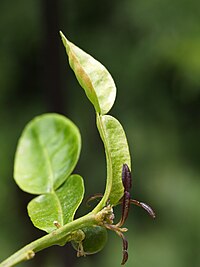Kaffir lime
| Kaffir lime | ||||||||||||
|---|---|---|---|---|---|---|---|---|---|---|---|---|

Kaffir lime ( Citrus hystrix ) |
||||||||||||
| Systematics | ||||||||||||
|
||||||||||||
| Scientific name | ||||||||||||
| Citrus hystrix | ||||||||||||
| DC. |
The kaffir ( Citrus hystrix ), also kaffir lime or Mauritius Papeda , or from French Combava is a plant from the genus Citrus Plants ( Citrus ) within the family of the Rutaceae (Rutaceae). It serves as a spice and medicinal plant .
origin

The kaffir lime comes from tropical Asia and is probably native to the Malay Peninsula . Today it is cultivated in all countries of the peninsula and also in Indonesia and was spread to the Caribbean and the USA by emigrants .
description
The kaffir lime is a small tree or shrub with thorn-reinforced branches. The leaf stalks are strongly widened ("winged"), which gives the impression of two leaves that have grown together lengthways. The leaves are very shiny and coated with a layer of wax.
The white, relatively small flowers develop into pear-shaped fruits that are typically 6 cm in size. The uneven, coarse black skin changes color from dark green to yellow as it ripens. However, kaffir lime fruits are almost always traded unripe, i.e. green.
The number of chromosomes is 2n = 18.
ingredients
The whole kaffir lime plant smells strongly aromatic and penetrating lemon-like. This odor is due to the monoterpene aldehyde citronellal . In the fruit peel, similar to lemon and lime , monoterpene hydrocarbons such as limonene were identified as the main component.
use
Kaffir limes are small and low in juice; therefore they do not play a role in the production of soft drinks. In addition to the use of kaffir lime oil in perfumery , the plant is particularly important in the culinary arts of Southeast Asia and the French overseas department of La Reunion .
The fresh leaves are mostly used in the kitchen. Similar to European bay leaves , they can be cooked in sauce or soup-like dishes, giving the food a piquant, lemon-like aroma; however, they are too tough to eat. In Thailand and Vietnam , the leaves are also cut into wafer-thin strips, so that they can be spiced up and eaten without any problems; in this form it is used for spicy meat salads in northern Thailand . In Thailand and Cambodia , spice pastes are also prepared that contain grated kaffir lime leaves.
In Malaysia and Indonesia the kaffir lime fruits are also used for seasoning. Either coarsely cut or squeezed kaffir lime can be cooked in stews (this inevitably creates a bit of bitterness from the mesocarp ), or only the outermost layer of the peel ( exocarp ) is used.
On La Reunion , the finely chopped pods of the fruit are mixed with rougail or samoussas .
See also
Individual evidence
- ↑ Citrus hystrix at Tropicos.org. In: IPCN Chromosome Reports . Missouri Botanical Garden, St. Louis
